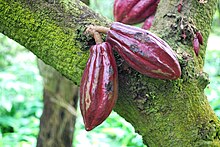Cocoa trees
| Cocoa trees | ||||||||||||
|---|---|---|---|---|---|---|---|---|---|---|---|---|

Cocoa tree ( Theobroma cacao ) |
||||||||||||
| Systematics | ||||||||||||
|
||||||||||||
| Scientific name | ||||||||||||
| Theobroma | ||||||||||||
| L. |
The cocoa trees ( Theobroma ) are a genus of trees from the mallow family . The natural range of the approximately 22 species is the tropical America. The best known representative of the genus is the cocoa tree , but cocoa and chocolate are also made from the seeds of other species.
description
The cocoa trees are trees with alternate, large and entire leaves . The hermaphroditic and small flowers grow individually or in umbels mostly on the trunk ( cauliflora ) or on larger branches ( ramifloria ). The calyx is five-lobed and divided almost to the base. The five petals are strongly concave in the lower area, become narrower in the middle and are spatulate in the outer area. The stamens grow in five groups of 1 to 3, which are arranged alternately to form five staminodes . The ovary is sitting, five-chambered with many ovules per chamber. The scar is five-lobed. The fruits are large berries (armored berries ) (or, according to another view, stone fruits ) with numerous seeds embedded in the pulp .
Distribution and ecology
The natural range of the species is in tropical Central and South America. They mostly grow in the undergrowth of tropical rainforests.
Systematics and research history



The cocoa trees ( Theobroma ) are a genus from the family of the Malvaceae (Malvaceae). There they are assigned to the subfamily Byttnerioideae, tribe Theobromateae. The genus was first scientifically described by Carl von Linné in 1753 in the second volume of Species Plantarum . The generic name Theobroma chosen by Linné comes from the Greek and is derived from theós for “god” and brôma for “food”, so together means “food of the gods”. The name refers to the products mainly made from the Theobroma cacao , namely cocoa and chocolate .
There are around 22 different types, including:
- Theobroma angustifolium Sessé et Moc. ex DC. : The home is Nicaragua, Costa Rica and Panama.
- Theobroma bernoullii Pittier : The homeland is Panama and Colombia.
- Theobroma bicolor Humb. et Bonpl. : It is probably native to Central America.
- Cocoa tree ( Theobroma cacao L. ): The home is Mexico, Belize, Guatemala and northern South America.
- Theobroma gileri Cuatrec. : The home is Colombia and Ecuador.
- Theobroma glaucum H. Karst. : The homeland is Colombia, Ecuador, Peru and Brazil.
- Theobroma grandiflorum (Willd. Ex Spreng.) K.Schum. - Cupuaçu or large-flowered cocoa: Its home is Brazil.
- Theobroma hylaeum Cuatrec. : The home is Panama and Colombia.
- Theobroma mammosum Cuatrec. et Jorge León : The home is Costa Rica.
- Theobroma microcarpum Mart. : The home is Brazil.
- Theobroma obovatum Klotzsch ex Bernoulli : The homeland is Colombia, Peru and Brazil.
- Theobroma simiarum Thursday. Sm . : The homeland is Nicaragua, Costa Rica, Panama, Colombia and Ecuador.
- Theobroma sinuosum Pav. Ex Huber : The home is Peru.
- Theobroma speciosum Willd. ex explos. : The homeland is Ecuador, Bolivia, Peru and Brazil.
- Theobroma subincanum Mart. : The home is Colombia, Venezuela, French Guiana, Peru and Brazil.
- Theobroma sylvestre Aubl. ex Mart. in Buchner : The home is Brazil.
- Theobroma velutinum Benoist : Home is Guyana, Suriname and Brazil.
use
Cocoa and chocolate are made from the seeds of the cocoa tree ( Theobroma cacao ), but also from other species such as Theobroma bicolor and Theobroma grandiflorum .
proof
literature
- Wu Zheng-yi, Peter H. Raven, Deyuan Hong (Eds.): Flora of China . Volume 12: Hippocastanaceae through Theaceae . Science Press / Missouri Botanical Garden Press, Beijing / St. Louis 2007, ISBN 978-1-930723-64-1 , pp. 321 (English).
- Helmut Genaust: Etymological dictionary of botanical plant names. 3rd, completely revised and expanded edition. Nikol, Hamburg 2005, ISBN 3-937872-16-7 , p. 640 (reprint from 1996).
- Bernd Nowak, Bettina Schulz: Pocket dictionary of tropical crops and their fruits . Quelle & Meyer, Wiebelsheim 2009, ISBN 978-3-494-01455-5 , p. 265-571 .
- Andreas Bärtels: Tropical Plants . Ornamental and useful plants. 5th, revised edition. Eugen Ulmer Verlag, Stuttgart 2002, ISBN 3-8001-3937-5 , p. 343 .
Individual evidence
- ↑ a b c Mei-chen Chang, Lien-ching Chiu, Zhi Wei, Peter S. Green: Theobroma . In: Wu Zheng-yi, Peter H. Raven, Deyuan Hong (Eds.): Flora of China . Volume 12: Hippocastanaceae through Theaceae . Science Press / Missouri Botanical Garden Press, Beijing / St. Louis 2007, ISBN 978-1-930723-64-1 , pp. 321 (English).
- ↑ Bärtels: Tropical Plants , p. 343
- ↑ a b c d e f g h i j k l m n o p q r Theobroma. In: Germplasm Resources Information Network (GRIN). United States Department of Agriculture, accessed June 14, 2017 .
- ↑ Exactly: Etymological Dictionary of Botanical Plant Names , p. 640
- ↑ Theobroma. In: The Plant List. Retrieved March 24, 2012 .
- ↑ Nowak, Schulz: Pocket dictionary of tropical useful plants and their fruits , pp. 566, 568, 569, 571